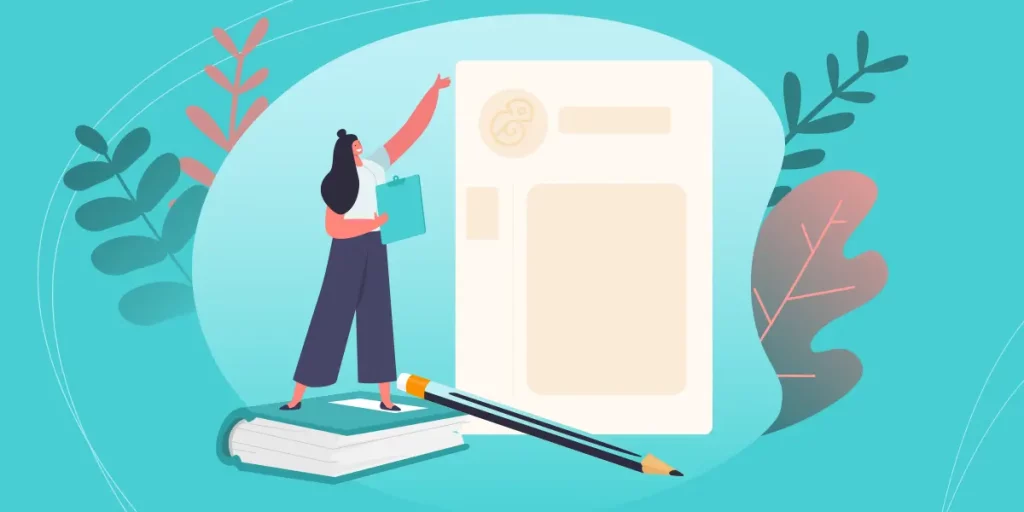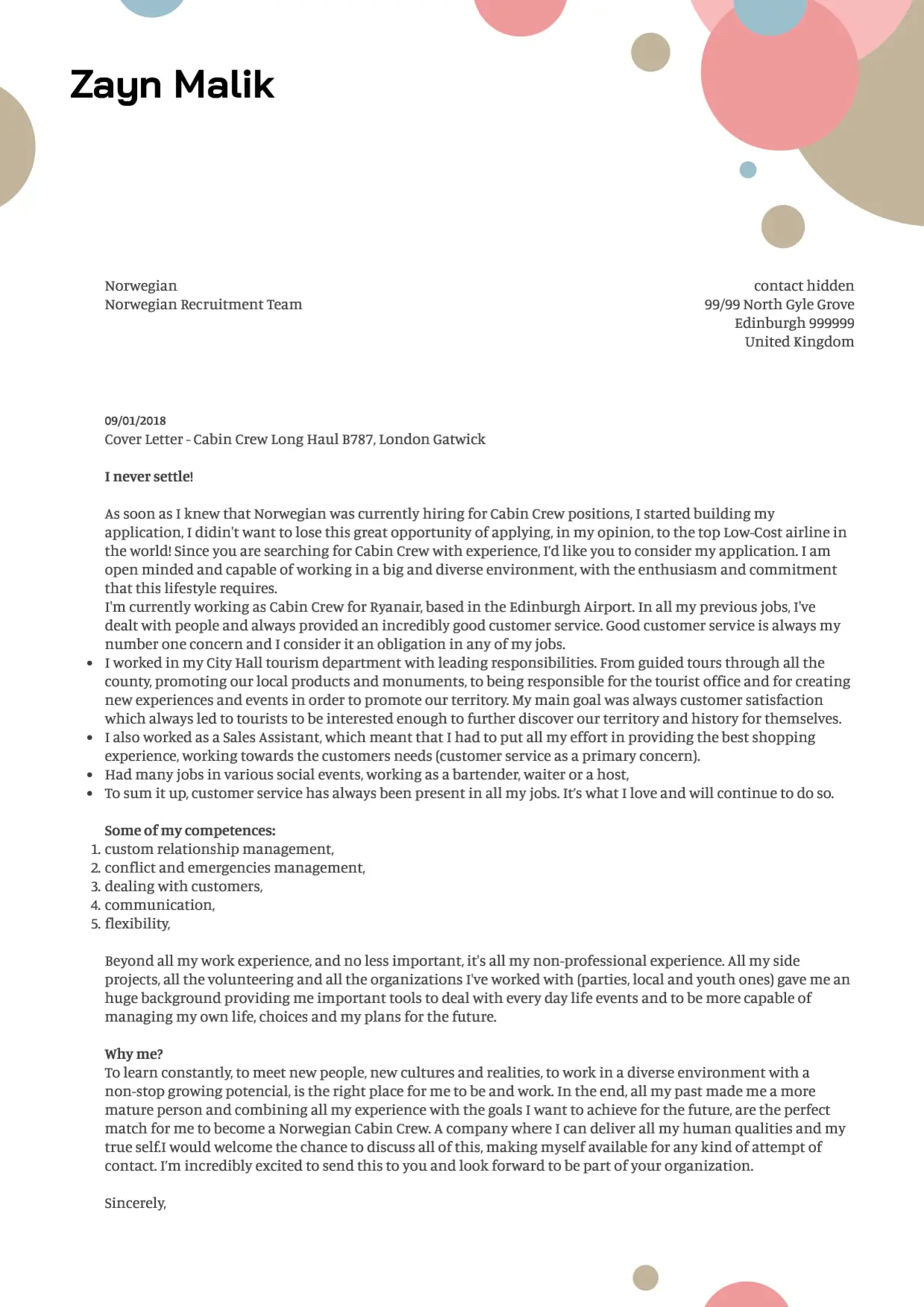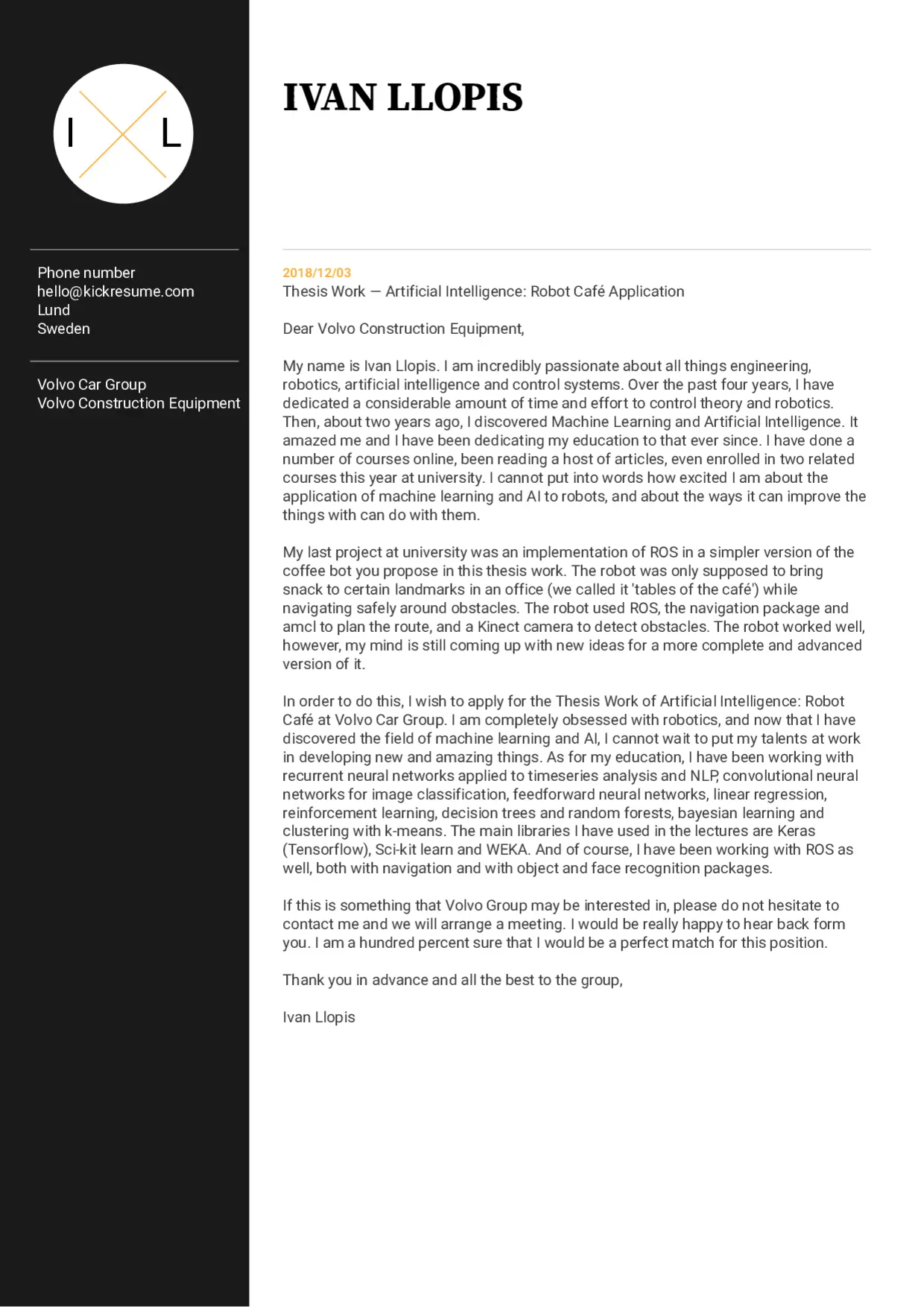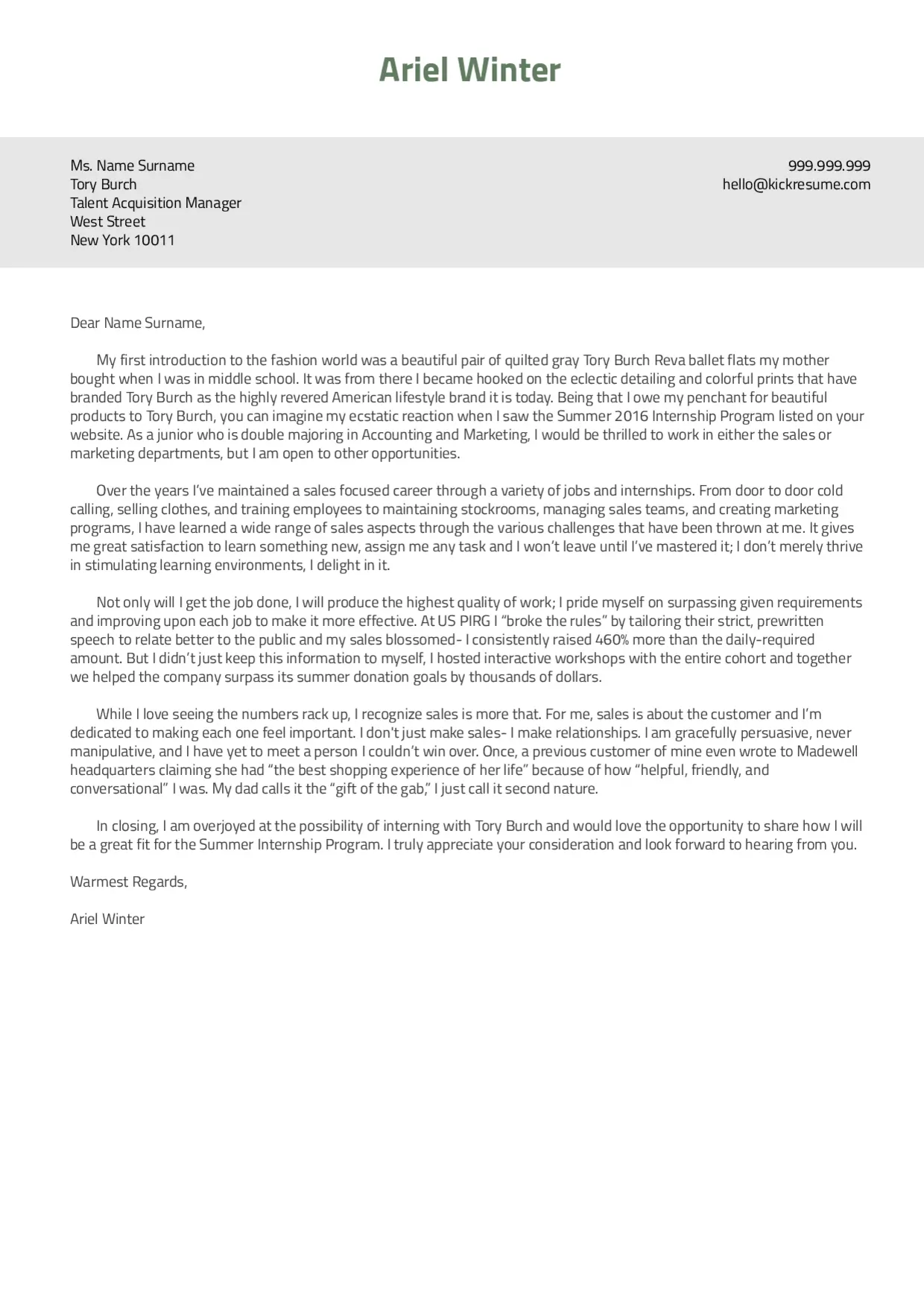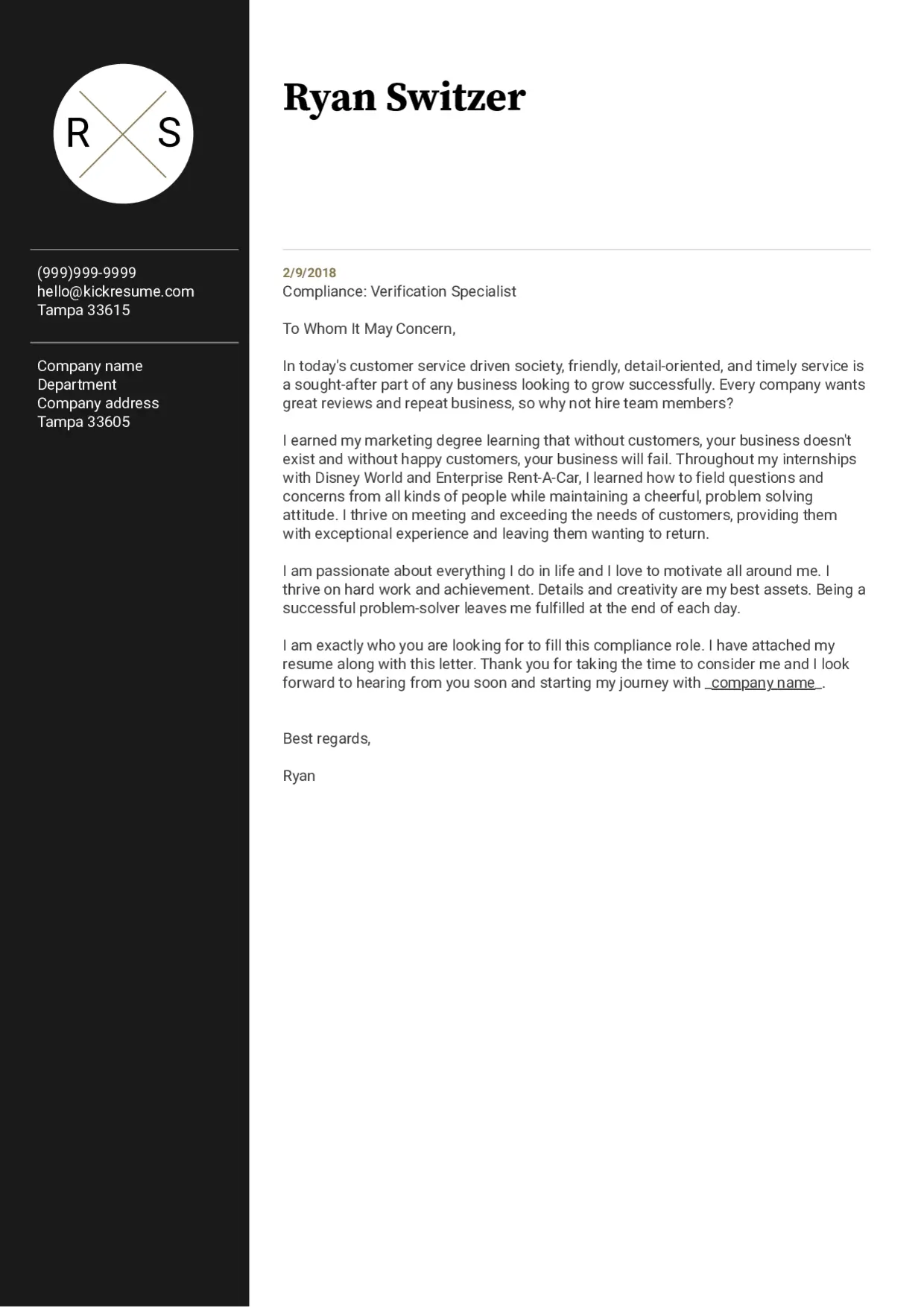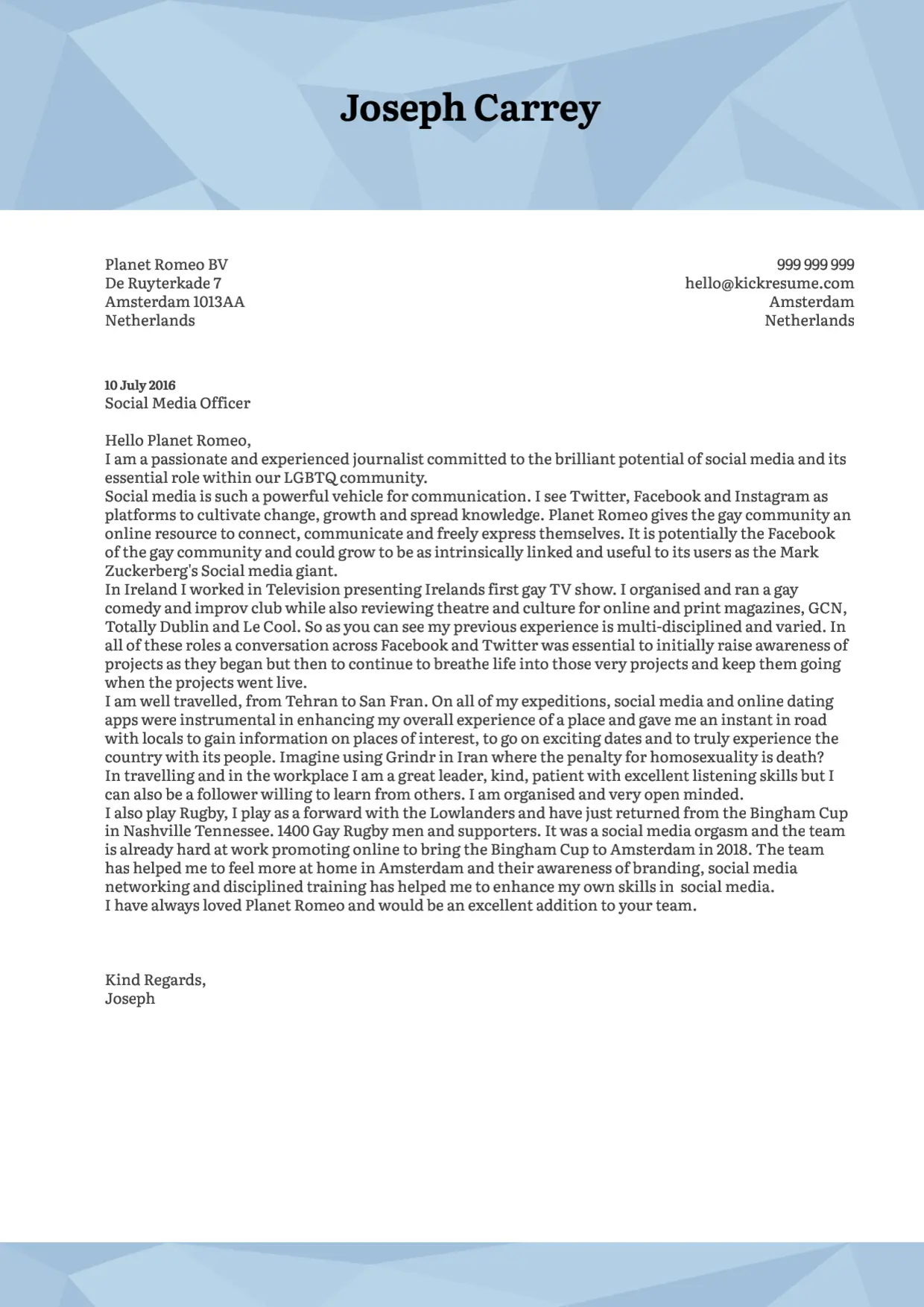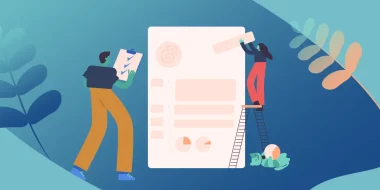Oh, the dreaded cover letter. Job seekers hate writing it and nobody knows if anybody even reads cover letters anymore. And yet, not attaching one to your application would be a terrible mistake. This cover letter guide will tell you not only why to write one, but also how to write a really good one.
But first, why does everyone hate writing cover letters so much? After all, a cover letter gives you a unique opportunity to distinguish yourself from others.
In comparison with a resume, the cover letter allows you to provide details that didn’t fit in on your resume and demonstrate your passion.
All the negativity that surrounds the cover letter probably comes down to the fact that good cover letters require a bit of alchemy. They also take time to write.
This guide will help you avoid any mistakes and write a strong cover letter that will catch the recruiter’s attention. We also include cover letter examples.
Generally speaking, you want to make your cover letter:
- easy to read for the recruiter;
- well-structured;
- typo-free;
- max 4 paragraphs/1 page long;
- professional in both tone and greetings;
- tailored for the specific opening.
Let's get to it!
Why should you write a cover letter?
So, how exactly is the cover letter important for your job application?
Some may argue that in 2025, the cover letter isn’t really relevant anymore. You’ve probably heard people write it off as a thing of the past that no one bothers to read.
Well, it’s not quite like that—at least according to the data:
- 77% of recruiters will give preference to candidates who did send a cover letter, even if submitting one is optional.
- 83% of hiring managers read the majority of cover letters they receive.
- Only 6% of hiring managers think that a cover letter is unnecessary for a job application.
One thing is certain: sending a cover letter won’t hurt your chances; it can only help them—significantly.
While your cover letter might get overlooked in a stack of applications, it’s far more likely to help you stand out from the competition.
Why? Simply because it shows you’re willing to go the extra mile.
And there's more to it.
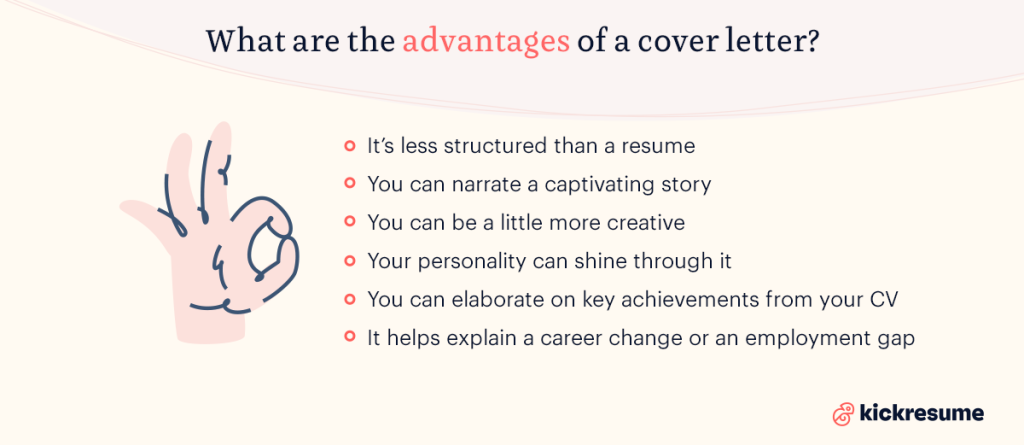
Some of the key advantages of the cover letter are:
- It’s much less structured than the resume and lets you develop a story.
- It gives you space to get a little more creative.
- Your personality can shine through thanks to it.
- You can elaborate on key achievements mentioned in your resume.
- It helps explain a lack of experience, career change, or an employment gap.
In other words, the cover letter is a perfect chance to bridge the distance between you and a recruiter even before the actual job interview.
How do recruiters read cover letters?
First, they read them to decide if you’re the right fit for a position. For this reason, avoid generic write-ups at all costs. What recruiters love to see is a short persuasive argument of why you fit the role and the company. Something like this:
Second, recruiters are looking for inconsistencies. For instance, if your resume shows attention to detail but your cover letter is addressed to the wrong person, wrong company, and is filled with typos, it's inconsistent. You want to ensure the number of inconsistencies is kept to a minimum.
Third, they're trying to get a hint of your personality. Cultural fit is important to many companies.
So, throughout the process of cover letter writing, it's essential to keep in mind the recruiter who's going to be the recipient of your letter.
Because at the end of a day, a good cover letter shouldn't be solely about you — it's supposed to be written with the hiring manager in mind.
So ask yourself:
- Is my cover letter easy to read?
- Have I addressed the right person in the opening?
- Will it help them decide if I'm the right fit?
- Did I use the right tone of voice that fits their company culture?
If you answered “no” to any of these questions, our cover letter guide is exactly for you.
How to write a great cover letter in 9 simple steps
Writing a cover letter may seem like a challenging task at first but if you know a few key cover letter rules, the process can become much easier.
- Prepare and do some research.
Before you start writing your cover letter, find out more about the company you're applying for. Look at their website and LinkedIn. The research also includes looking at the job description very closely and identifying any recurring keywords. Also, search for specific cover letter examples for the role online.
- Include a header with basic information.
Placed at the very beginning of your cover letter, the header is where you include your contact information (i.e. your full name, email address, phone number) and the company's contact information (i.e. the manager’s or recruiter’s name, job title, department, the name of the company, company’s address).
- Write a strong cover letter headline.
When in doubt, try to use this formula: Number or Trigger word + Adjective + Keyword + Promise. The result can look something like this: 5 Ways I Can Help You Improve Your Company’s [insert a position-related keyword]
- Use the correct form of greeting.
If the name of the hiring manager isn't written in the job posting, research their name and contact information online. For example, look at the company's page or LinkedIn. Then, greet them by saying "Dear [first name]". If, however, the company culture is very formal, go for the classic "Dear Hiring Manager".
- First paragraph: Introduce yourself with a BANG!
The first paragraph is the perfect place to shortly explain why the job seems exciting to you and why you’re the right person for it. You can also compliment the company or name a mutual acquaintance who referred you.
- Second paragraph: Explain why you’re a great fit for the company.
Try to answer these questions:
1. What did you do at a previous position that gave you relevant experience?
2. How could this experience help the new company grow?
3. Which of the projects you have worked on would benefit their business?
4. Which of your skills make you well-equipped for the position?
5. Do any of these skills give you an edge over other candidates? - Third paragraph: Explain why the company is a great fit for you.
The following questions should help you:
What excites you about the idea of working at this company?
How do the company goals align with your own?
What do you hope to gain and learn from working there? - Closing paragraph: Finish strong and stay in touch.
In the cover letter closing paragraph: reiterate that your experience and enthusiasm make you a great candidate, add a confident call to action, express gratitude, and always use a formal sign-off.
- How do you send a cover letter?
You can either attach the cover letter as a separate document in the email when sending your resume, or send it directly in the body of the email (that way they can't ignore it).
In the following chapters we look at each step more closely and include specific examples you can copy and paste.
Step 1: Prepare and do some research
Knowledge is power. Before you begin writing:
- Find out more about the company and the position you're applying for. Spend some time on the company’s website, its executives’ Twitter feeds, and employee profiles on LinkedIn. It will also help you decide on the tone of your cover letter. For example, if it’s a company like Kickresume, you can easily get away with more unusual approaches. But if it’s a conservative institution, like a bank or a lawyer's office, you should probably keep it formal.
- Search for specific cover letter examples for your role online. Pick some examples that fit your role and use these for inspiration. (By the way, that link just now will take you to our database of successful cover letters from real people who got hired. Totally worth checking out.)
- Look at the job descriptions of the roles you’re applying for. Identify major experience and hard skill keywords, so you can insert them in your letter in the relevant sections.
Once you've done this basic research, you can finally start thinking about the structure of your cover letter.
This short infographic will show you that writing a cover letter is a lot simpler than you might have thought:
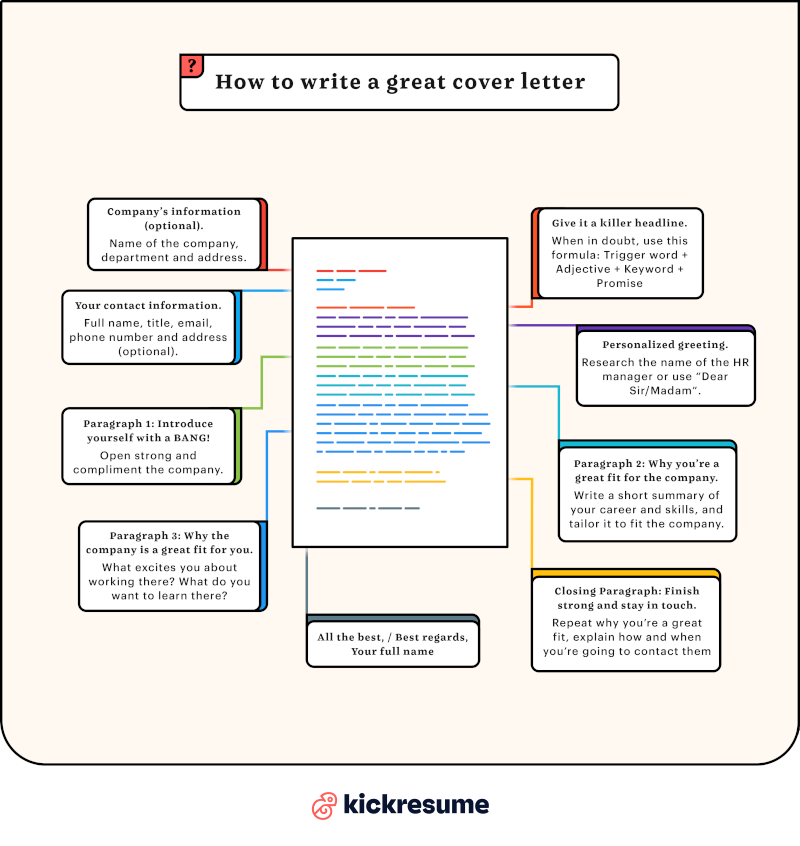
Step 2: Include a header with basic information
Placed at the very beginning of your cover letter, the header is the place where you should include your contact information and the contact information of the company.
A cover letter is still a letter, after all.
At the left side of the page include the information based on which you can be reached by the recruiter.
Here, make sure to include:
- your full name
- your email address
- phone number
Optionally, you can also add:
- your professional title
- address (if it vaguely matches the location of the job offer)
- current date
- personal website/LinkedIn
The top right side of the page is reserved for company-related information. Here, you should put:
- the manager’s or recruiter’s name (if available)
- job title
- department
- the name of the company
- company’s address
Step 3: Write a strong cover letter headline
When you’re browsing the web, what articles usually catch your attention? Those with great headlines, of course!
The same applies to cover letter headlines.
Start by paying attention to the headlines around you — especially in tabloids and websites like Buzzfeed (Is Buzzfeed still a thing? How very 2010s of me). These are usually designed to stir up your interest and make it impossible to not click through.
Notice how they use numbers, questions, and interesting adjectives to promise the reader to learn something valuable.
And you can do the same in your cover letter.
When in doubt, try to use this formula: Number or Trigger word + Adjective + Keyword + Promise.
The result can look something like this:
Finally, don’t forget to adjust your header to the company’s level of formality and put your headline in the subject of the email.
Step 4: Use the correct form of greeting
In this time and age, there’s no excuse for using “To Whom It May Concern.”
If the name of the hiring manager isn't written in the job posting, you’re expected to research their name and contact information online. For example, look at the company's page or LinkedIn.
Once you have their name, feel free to go for a personalized greeting:
Honorifics (e.g. Mr., Mrs., Ms.) are more appropriate if the company’s culture is formal.
And if you cannot find the recruiter’s name, it's okay to go for a generic:
Alternatively, you can address the letter to the whole company team or the HR department. In this case, your greeting should look like this:
Step 5: First paragraph: Introduce yourself with a BANG!
The best way to start a cover letter is to open strong. The first impression matters the most and busy recruiters often have a chance to properly dive into only a few selected cover letters.
So if you make your first paragraph captivating, chances are that your letter will be one of the lucky ones that actually end up being read.
In fact, the first paragraph is the perfect place to shortly explain why the job seems exciting to you and why you’re the right person for it.
While most people begin their letters with “I’m applying for the position X I saw in Y place,” it's a waste of space.
Instead, open with a sentence like this:
In the first paragraph, you can also:
- Compliment the company. Show that you know details about the company and you’re approaching it for a reason. For example, demonstrate appreciation for what the company does. Not only will this flatter them, but it will also provide them with insight into who you are.
- Name a mutual acquaintance if you can. This is sometimes called a “magic bullet,” as it’s the one thing that will assure the hiring manager reads your cover letter until the end.
However, limit the introduction to 1-3 sentences. This isn’t the place to go into detail about what makes you ideal for the role — save that for the second and third paragraphs.
Step 6: Second paragraph: Explain why you’re a great fit for the company
The second paragraph is the place where you should sell yourself and your experience.
Here, write a short summary of your career, skills and accomplishments, tailored to fit what the company is looking for.
You already did your research, so now it's time to ask yourself these questions and try to address them in your cover letter:
- What did you do at a previous position that gave you relevant experience?
- How could this experience help the new company grow?
- Which of the projects you have worked on would benefit their business?
- Which of your skills make you well-equipped for the position?
- Do any of these skills give you an edge over other candidates?
After you’ve picked the most relevant accomplishments, put them at the start of your letter.
However, when talking about them, avoid sounding like you’re bragging. The best way of doing this is to focus on your experiences rather than yourself. Ideally, support your claims with concrete examples.
Also, mention any other additional relevant hard skills or knowledge areas they’re looking for, as well as any qualifications.
Finally, the second paragraph is the perfect place for showing that you’ve done your research. Demonstrate that you’re familiar with some of the challenges that the company faces and present how you can help them.
Step 7: Third paragraph: Explain why the company is a great fit for you
In this paragraph, you want to show that you’re serious about developing your career at this new company. And good companies want to know why they appeal to you and how will your professional relationship be mutually beneficial.
Consider addressing the following questions:
- What excites you about the idea of working at this company?
- How do the company goals align with your own?
- What do you hope to gain and learn from working there?
For example, you can say something like this: “I've seen on your website that you heavily focus on cryptocurrency projects. As a cryptocurrency enthusiast, I would love to join your team”.
However, don’t go overboard with flattery and stay professional.
Also, don’t say anything that isn't true or you don’t mean it, as it will probably come up again in the later stages of the application process.
Step 8: Closing paragraph: Finish strong and stay in touch
Now that you’ve nailed the main part of your cover letter, you also want to finish strong. This way, the recruiter will remember you in a good light. But how do you achieve that?
- Reiterate that your experience and enthusiasm make you a great candidate. This is to emphasize the two main points from the previous paragraphs. Do this in one or two sentences, not more.
- Add a confident call to action. In a sentence or two, you should suggest the next steps. Something like “I would love the opportunity to meet with you and discuss the value I can bring to [company]."
- Express gratitude. Simply thank them for their time and for considering your application.
- Always use a formal sign-off. Something like “Sincerely, Best wishes, or Respectfully”. Finish by typing out your full name.
Step 9: How do you send a cover letter?
I can’t stress this enough — unless it's specifically required to attach the cover letter to the body of the email, consider not sending your cover letter as a document attached to your email.
Instead, put it inside the body of the email. The email itself is now your cover letter! This way the recruiter won't ignore it.
However, remember that hiring managers receive hundreds of emails a day. So if you want your email to get read, it's the subject line that's likely to play the most important part.
As we've advised before, if you have a good resume headline, simply put it in the email subject.
However, if you’re unhappy with the result, you have other options, too.
For instance, if you have a reference, include it already in your email subject line:
If you don't have a reference or a catchy headline, check out more tips on how to write the best subject line for your email.
What if you're told to NOT submit a cover letter?
Today, many companies are using online application systems that discourage applicants from attaching a cover letter.
Instead, they have their own application systems where in different sections you're required to fill in the information you would normally place in your cover letter.
If this is the case, just work with the format they gave you.
In other words, include the same information that you'd normally have in your cover letter but place it in the correct sections.
And don’t forget to follow the cover letter principles:
- explain why you're the right candidate;
- make it clear that you've researched the company well;
- indicate in what way you'd be an asset;
- mention your biggest past achievements.
Because no matter the format, you're still expected to present your skills and convey enthusiasm about the job.
Alternatively, you can also try to find a relevant manager or a recruiter online (either on the company pages or LinkedIn) to whom you can send a brief follow-up email with an attached cover letter.
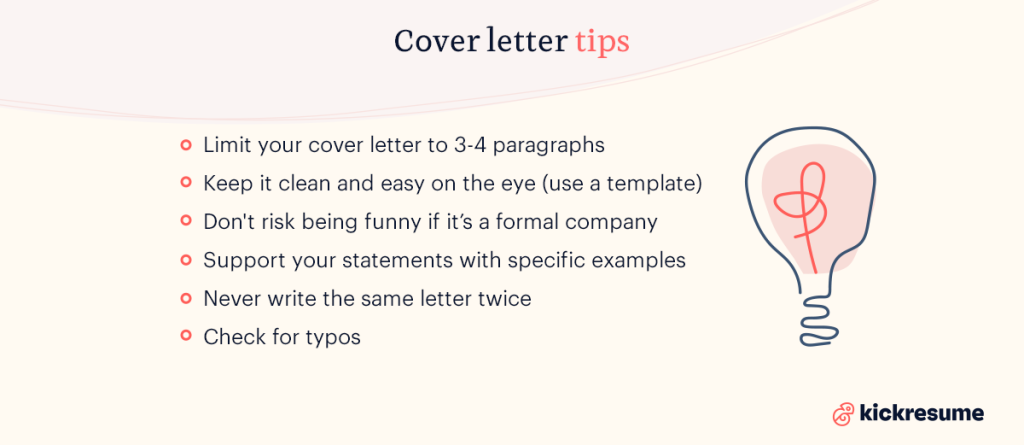
Final cover letter tips and hacks
Now that we've covered the basics, there are several other tips that you should keep in mind to elevate your cover letter to the next level:
- Keep it short. Limit your cover letter to three to four paragraphs and a maximum of one page. Hiring managers are busy people who often don't have time for reading long texts.
- Keep it clean and easy on the eye. Take a look at how this article is written. It’s replete with short paragraphs, sentences typed in bold letters, bullet points, and numbers. All of these make reading and searching for specific information easier. So, never send a letter that looks like an unreadable wall of text. The easiest way to achieve a sleek cover letter design is to use a pre-formatted cover letter template.
- Don’t risk being funny if it’s a company with a formal work culture. Poorly executed humor will hurt your chances rather than help. Being direct and dynamic is a much surer way to catch the recruiter’s attention than a number of jokes. On the other, if the company is smaller or known for its creative products, being original may in fact help your chances!
- Show, don’t tell. Usually, there’s no point in saying you’re “a dependable hard worker” or “a creative thinker.” Why should anyone believe such generic statements? Instead, offer an example of how these qualities helped you achieve something in the past.
- Never write the same letter twice. A cover letter should always be tailored to a specific job application. Remember the previous sections? You’ve made a great effort to research the company and its hiring managers, so you’ve written your cover letter accordingly. This is a process you need to repeat with every application (ugh, I know).
- Check for typos. This goes without saying but make 100% sure your cover letter is without typos. There’s no reason to believe you're competent if you can't even type without errors. Moreover, typos automatically reveal almost criminal carelessness on your part, since every text editor nowadays has a spellchecking feature.
- Don't use any buzzwords. Your cover letter needs to be authentic and persuasive — and buzzwords are neither. If anything, they simply give the impression of you being someone who's just trying to fit a skewed idea of what an ideal corporate employee should be. Instead, focus on using relevant keywords from job descriptions.
Now, if you have no experience yet because you're just starting out or you're changing careers, writing a cover letter can be scary. However, a well-written letter can actually be your best friend.
And this is how you write the perfect cover letter with no experience.
Cover letter examples
In the end, there are many different ways to write a great cover letter. And even if you follow the cover letter guide above, you’ll end up with a cover letter that's invariably your own.
It all depends on your own personality, the position you’re applying for, and the hiring manager’s preferences.
And that's good, actually!
Still, there's a lot to learn from cover letters written by other people. That's why we've selected five cover letter samples that deserve your attention.
Each of these helped real job seekers find real jobs in real companies. They'll teach you valuable lessons you can use in your own cover letter.
Do you still need some more inspiration? You can find more examples in our cover letter library
FAQ: How to write a cover letter
- 1. How long should a cover letter be?
250 to 400 words is the standard cover letter length range. A cover letter should never exceed one page.
- 2. The application says that a cover letter is optional. Should I still send it?
Yes! Show that you can go that extra mile and stand out from the crowd of applicants.
- 3. How should I format a cover letter?
Ideally, use a pre-formatted cover letter template. Then use a simple and professional font, such as Times New Roman. The font size should be between 10-12.
- 4. Who should I address the cover letter to?
If you have the name of the hiring manager, try to find their contact on the company page or LinkedIn. If you still can't find the right person, you can address it to the whole team or HR.
5. What should I include in a cover letter to make it stand out?To stand out, start by tailoring your cover letter to the job opening. Focus on highlighting your relevant skills and experience, and show how your values and goals align with the company’s. Include any relevant keywords from the job description, and don’t forget to keep it short, clear, and to the point.
This article was recently updated. The original article was written by Martin Poduska in 2017.
